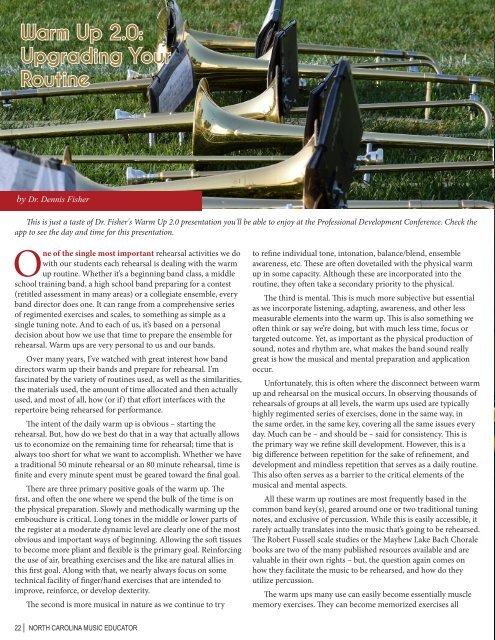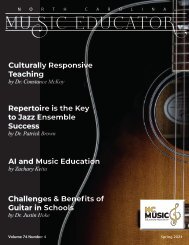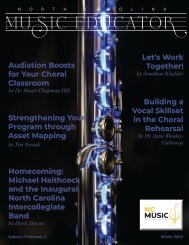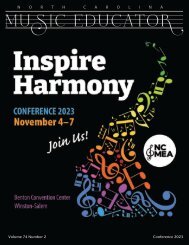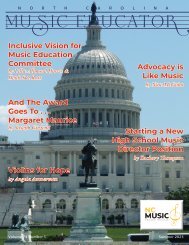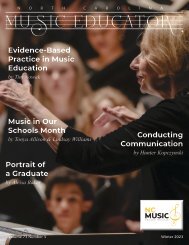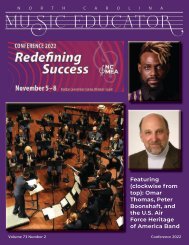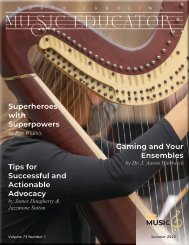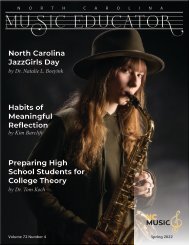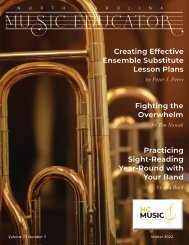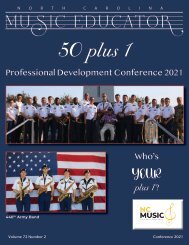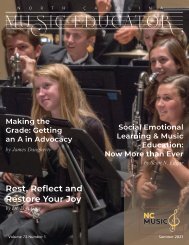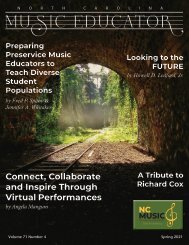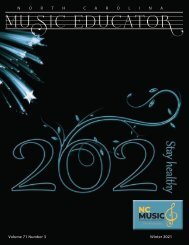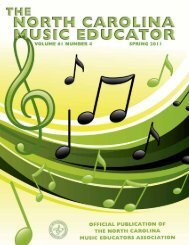NC Music Educator Conference 2019
NCMEA Journal, Conference 2019 edition
NCMEA Journal, Conference 2019 edition
You also want an ePaper? Increase the reach of your titles
YUMPU automatically turns print PDFs into web optimized ePapers that Google loves.
Warm Up 2.0:<br />
Upgrading Your<br />
Routine<br />
by Dr. Dennis Fisher<br />
This is just a taste of Dr. Fisher's Warm Up 2.0 presentation you'll be able to enjoy at the Professional Development <strong>Conference</strong>. Check the<br />
app to see the day and time for this presentation.<br />
One of the single most important rehearsal activities we do<br />
with our students each rehearsal is dealing with the warm<br />
up routine. Whether it’s a beginning band class, a middle<br />
school training band, a high school band preparing for a contest<br />
(retitled assessment in many areas) or a collegiate ensemble, every<br />
band director does one. It can range from a comprehensive series<br />
of regimented exercises and scales, to something as simple as a<br />
single tuning note. And to each of us, it’s based on a personal<br />
decision about how we use that time to prepare the ensemble for<br />
rehearsal. Warm ups are very personal to us and our bands.<br />
Over many years, I’ve watched with great interest how band<br />
directors warm up their bands and prepare for rehearsal. I’m<br />
fascinated by the variety of routines used, as well as the similarities,<br />
the materials used, the amount of time allocated and then actually<br />
used, and most of all, how (or if) that effort interfaces with the<br />
repertoire being rehearsed for performance.<br />
The intent of the daily warm up is obvious – starting the<br />
rehearsal. But, how do we best do that in a way that actually allows<br />
us to economize on the remaining time for rehearsal; time that is<br />
always too short for what we want to accomplish. Whether we have<br />
a traditional 50 minute rehearsal or an 80 minute rehearsal, time is<br />
finite and every minute spent must be geared toward the final goal.<br />
There are three primary positive goals of the warm up. The<br />
first, and often the one where we spend the bulk of the time is on<br />
the physical preparation. Slowly and methodically warming up the<br />
embouchure is critical. Long tones in the middle or lower parts of<br />
the register at a moderate dynamic level are clearly one of the most<br />
obvious and important ways of beginning. Allowing the soft tissues<br />
to become more pliant and flexible is the primary goal. Reinforcing<br />
the use of air, breathing exercises and the like are natural allies in<br />
this first goal. Along with that, we nearly always focus on some<br />
technical facility of finger/hand exercises that are intended to<br />
improve, reinforce, or develop dexterity.<br />
The second is more musical in nature as we continue to try<br />
to refine individual tone, intonation, balance/blend, ensemble<br />
awareness, etc. These are often dovetailed with the physical warm<br />
up in some capacity. Although these are incorporated into the<br />
routine, they often take a secondary priority to the physical.<br />
The third is mental. This is much more subjective but essential<br />
as we incorporate listening, adapting, awareness, and other less<br />
measurable elements into the warm up. This is also something we<br />
often think or say we’re doing, but with much less time, focus or<br />
targeted outcome. Yet, as important as the physical production of<br />
sound, notes and rhythm are, what makes the band sound really<br />
great is how the musical and mental preparation and application<br />
occur.<br />
Unfortunately, this is often where the disconnect between warm<br />
up and rehearsal on the musical occurs. In observing thousands of<br />
rehearsals of groups at all levels, the warm ups used are typically<br />
highly regimented series of exercises, done in the same way, in<br />
the same order, in the same key, covering all the same issues every<br />
day. Much can be – and should be – said for consistency. This is<br />
the primary way we refine skill development. However, this is a<br />
big difference between repetition for the sake of refinement, and<br />
development and mindless repetition that serves as a daily routine.<br />
This also often serves as a barrier to the critical elements of the<br />
musical and mental aspects.<br />
All these warm up routines are most frequently based in the<br />
common band key(s), geared around one or two traditional tuning<br />
notes, and exclusive of percussion. While this is easily accessible, it<br />
rarely actually translates into the music that’s going to be rehearsed.<br />
The Robert Fussell scale studies or the Mayhew Lake Bach Chorale<br />
books are two of the many published resources available and are<br />
valuable in their own rights – but, the question again comes on<br />
how they facilitate the music to be rehearsed, and how do they<br />
utilize percussion.<br />
The warm ups many use can easily become essentially muscle<br />
memory exercises. They can become memorized exercises all<br />
INTENSE FOCUS<br />
Ranked among the best programs in the country,<br />
U<strong>NC</strong>SA School of <strong>Music</strong> combines highly personalized instruction<br />
from major studio teachers with numerous opportunities to perform<br />
in ensembles and productions of all sizes. We’re instrumental in<br />
preparing students for the professional world of music.<br />
DA<strong>NC</strong>E DESIGN & PRODUCTION DRAMA FILMMAKING MUSIC<br />
uncsa.edu<br />
22 | NORTH CAROLINA MUSIC EDUCATOR NORTH CAROLINA MUSIC EDUCATOR | 23


